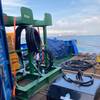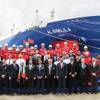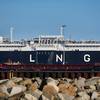By Larry Pearson
The year 2004 was a watershed year for the passenger vessel industry. The first two American flagged fast passenger and vehicle ferries went into service and equally important was that business was up in all sectors of the marketplace.
There is more variety as well. For the first time in several years, new casino boats are being built. One is for an operator in Michigan City, Indiana, a vessel being built at Chicago Bridge & Iron as a replacement boat for a vessel now almost 10 years old. A second is for the Lake Charles, La. Subsidiary of Pinnacle Entertainment, a Las Vegas-based gaming company. This is a 330-ft. by 225-ft. powered barge built by Leevac Shipyards, Jennings, La.
"We see a definite improvement in our business over the past few years," said Andy Lebet, vice president of DeJong & Lebet, naval architects and marine engineers of Jacksonville, Fla. Lebet's firm is a major designer of passenger vessels. Lebet was discussing the passenger vessel market with this reporter at the WorkBoat Show held in New Orleans. Behind Lebet were photos and drawings of several recent passenger vessel projects punctuating his upbeat feeling about this market.
This article looks at five major categories of passenger vessels: excursion boats under 149 passengers, known as Subchapter T vessels; excursion vessels over 149 passengers referred to as K boats and three classes of ferry boats, fast passenger only, fast passenger/vehicle and passenger; and vehicle carriers traveling under 20 knots.
Excursion Vessels-Above 149
Passengers (Subchapter K)
Excursion vessels that have more than 150 passengers typically are sized for 300-400 passengers since tighter U.S. Coast Guard regulations apply even if the vessel is sized for one passenger over the 149-passenger limit. The regulations for Subchapter K vessels mostly address structural fire protection, flammability of interior materials and other passenger safety issues. For some time now Skipperliner of Lacrosse, Wis. has been building vessels in this size range for a number of clients. In early 2004, Skipperliner delivered the 148-ft. long by 32-ft. wide, Majestic, 400-passenger vessel to Pacific Avalon Yacht Charters of San Diego, Ca.
The vessel began service in May of 2004. Pacific Avalon has a fleet of four vessels, all built by Skipperliner. The Majestic is the largest vessel in their fleet and the largest passenger vessel built by Skipperliner. All of the vessels work exclusively in the charter business with weddings being their largest individual market.
The $4.5 million yacht has a 400-passenger capacity with 300 passengers allowed on any one deck, a positive feature when that many people may be on one deck for a wedding ceremony or other event. The Majestic has three passenger decks with primary restroom facilities in the hull. "The boat has a 10-ft. deep hull, so we could effectively use this space for restrooms, freeing up space on the upper decks for passenger events," said Todd Jordan, director of marketing for Skipperliner.
Seating for 250 passengers is available on the main deck in rounds of 10. The second deck is a lounge with leather couches, a dance floor, bar and other amenities. The third deck is open but canopied aft with the pilothouse forward and a Bride's changing room. Private space for the bride and her attendants has become a welcome amenity on vessels that are marketed to the bridal market.
A pair of Caterpillar 3406E engines producing 600 hp each supplies power for the boat. Two John Deere 6081 engines power two 150 kW generators and a PTO off one of the main engines powers a 150 hp bow thruster by Wesmar.
Both of these vessels continue the trend of building vessels with upscale interiors intended to appeal to charter groups such as weddings and corporate events. Several more such yachts are being built in 2005 including one for New Orleans Steamboat that will go out for bid this spring.
High Speed Passenger Ferries
Two shipyards building vessels by Incat Designs of Sydney, Australia have built over 50 high-speed passenger ferries in the past few years. A very unique high-speed ferry was built in 2004 by Gulf Craft, Patterson, La. Gulf Craft, known best for their crew/supply boats, had their Australian designer, Crowther Multihulls design a 300-passenger 351-ft. passenger ferry for Key West Express, Ft. Myers, Fla. Key West Express has a fleet of three fast ferries serving Key West, Fla. from a terminal in Ft. Myers year around and Marco Island in season.
The 34-ft. wide Big Cat Express was delivered in January 2004 and makes the trip in 3-3.5 hours at a top speed of 38 knots. Gulf Craft called on their experience as a builder of fast crew/supply boats using the same engine setup used on many of their oil field boats.
A pair of Cummins KTA50-M2 engines are mounted in each hull of the catamaran driving Hamilton HM-651 waterjets through NICO offset reduction gears. Total horsepower is 7,200. Two Cummins engines also power 75 kW generators one mounted in each hull.
The vessel is designed with a partially enclosed main cabin that can seat 150 passengers. This space also holds 24 gaming machines and a snack bar. The second deck has enclosed seating for 80 persons in a VIP business class arrangement aft of the pilothouse and an open second deck area with 104 seats. The upper sun deck has seating for 44 passengers. There are five 48-in. plasma televisions onboard with digital satellite reception.
The company also operates the Big M casino boat out of Ft. Myers with a complete array of casino games. Two daily cruises are offered.
High Speed Passenger and
Vehicle Ferries
As noted in the intro of this story, 2004 was the year that large high-speed passenger and vehicle ferries were introduced for the first time in the U.S. Two ferries were introduced this summer on Great Lakes routes and the early returns shows that one was mostly a success while the second was a complete flop.
First the bad news. The $42.5 million vessel Spirit of Ontario built in Australia to run across Lake Ontario from Rochester, NY to Toronto, Canada. suspended service after three months of service awash in red ink. The December issue of Marine News chronicles this debacle with an interview with the driving force behind the venture.
Now for the relatively good news. Lake Express, a U.S. flagged vessel built by Austal USA, Mobile, Ala. (ironically the parent company Austal Ships of Australia built the Spirit of Ontario) ended its 2004 service two months early but met its passenger projections, according to ferry spokesperson Jeff Fleming.
The 192-ft. by 57-ft. all-aluminum catamaran began its 76-mile trans Lake Michigan route between Milwaukee, Wisc. and Muskegon, Mich. on June 1 and halted service at the end of October. The service is expected to resume April 30, 2005. "We failed to market the availability of service to the end of the year," said Lake Express President Ken Szallai. "The popular assumption is that Lake Michigan service is only offered in the summer and fall and we did not do enough marketing to counter this idea," Szallai added. As a result ridership was projected to down significantly the last two months of the year.
Even so, the Lake Express got rave reviews from tourism officials during it first season of operation. "Now that we understand its potential, we can move forward to a fantastic season in 2005," said Cindy Larsen, president of the Muskegon Area Chamber of Commerce.
The vessel, that has a capacity of 253 passengers and 46 vehicles, carried more than its goal of 100,000 passengers in spite of a five-month rather than a seven-month season.
Powered by four MTU 16V 4000 M70 engines, the Lake Express is capable of a speed of 34 knots using Kamewa 80 SII waterjets, allowing the ferry to cross Lake Michigan in under 2.5 hours.
Next season the vessel will offer upgrades in both facilities and on-board amenities.
Traditional Ferries
The Alaska Marine Highway System (AHMS) made big news this year with the introduction of the fast passenger/vehicle ferry Fairweather on the Sitka- Juneau route. Its quartet of MTU 16V595TE70 engines drive the ferry to a top speed of 43 knots and a cruise speed of 32 knots. The vessel has a length of 235 ft. and a 60-ft. beam. Passenger capacity is 250 people, small for a boat of this size but the AMHS decided not to make the decks of the vessel "wall-to-wall seats. Rather the vessel has lounges and other passenger hospitality areas.
Not as well publicized, but equally valuable to AMHS was the slower speed passenger/vehicle ferry Lituya. The steel-hulled vessel more resembles an offshore supply boat than a traditional ferry with an open main deck and a center island with a passenger lounge topped by a pilothouse. It was a case of form following function, according to Tom Atwood, an AMHS manager and on site construction manager as the vessel was being built at Conrad Industries, Morgan City, La.
The vessel shuttles between the mainland port of Ketchikan and the tiny island of Annette, home for the Metlakatla Indian tribe.
"Rough weather is often encountered on this route and since this is 24-hour a day service, we needed a vessel that can handle rough seas and can shed water quickly," said Atwood. "A supply boat design is proven to handle those conditions," Atwood added.
The 181-ft. Lituya has a 50-ft. beam and is powered by a pair of Caterpillar 3508B engines rated at 1,000 hp. This propulsion power setup is the same as many similar-sized supply boats. A 200 hp Thrustmaster bow thruster completes the propulsion system. Top speed of the ferry is14 knots and passenger capacity of 149 passengers with a crew of five.
In spite of her supply boat look, the Lituya is a Subchapter T passenger vessel for Lakes, Bays and Sounds under 100 gross tons.
Subscribe for
Maritime Reporter E-News
Maritime Reporter E-News is the maritime industry's largest circulation and most authoritative ENews Service, delivered to your Email five times per week










